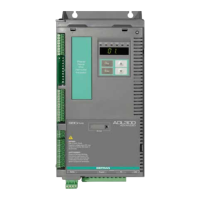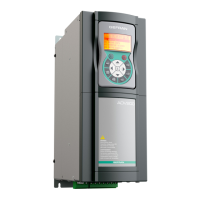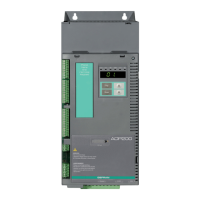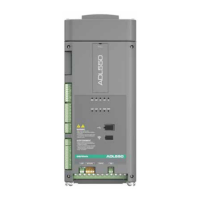ADL300 • Quick installation guide - Specifications and connection 107
Code Error message shown
on the display [on the
integrated keypad]
Sub-code Description
41 Watchdog [WDT]
Condition: this condition can occur during operation when the watchdog micro protection is enabled; the alarm is included in the list of alarms and alarm
log. After this alarm:
- the drive automatically runs a reset
- motor control is not available.
XXXXH-X The XXXXH-X code indicates the reason for the error: make a note of this to discuss it with the service centre.
Solution: If the alarm is the consequence of a change in the drive configuration (parameter setting, option installation, PLC application download)
remove it.
Turn the drive off and then on again.
42 Trap error [TRAP]
Condition: this condition can occur during operation when the trap micro protection is enabled; the alarm is included in the list of alarms and alarm log.
After this alarm:
- the drive automatically runs a reset
- motor control is not available.
XXXXH-X The XXXXH-X (SubHandler-Class) code indicates the reason for the error: make a note of this to discuss it with the service centre.
Solution: If the alarm was a consequence of a variation to the drive configuration (parameter setting, installation of an option, downloading of a PLC
application), remove it.
Switch the drive off and then switch it on again.
43 System error [SYS]
Condition: this condition can occur during operation when the operating system protection is enabled; the alarm is included in the list of alarms and alarm
log. After this alarm:
- the drive automatically runs a reset
- motor control is not available.
XXXXH-X The XXXXH-X (Error-Pid) code indicates the reason for the error: make a note of this to discuss it with the service centre.
Solution: If the alarm was a consequence of a variation to the drive configuration (parameter setting, installation of an option, downloading of a PLC
application), remove it.
Switch the drive off and then switch it on again.
44 User error [USR]
Condition: this condition can occur during operation when the software protection is enabled; the alarm is included in the list of alarms and alarm log.
After this alarm:
- the drive automatically runs a reset
- motor control is not available.
XXXXH-X The XXXXH-X (Error-Pid) code indicates the reason for the error: make a note of this to discuss it with the service centre.
Solution: If the alarm was a consequence of a variation to the drive configuration (parameter setting, installation of an option, downloading of a PLC ap-
plication), remove it.
Switch the drive off and then switch it on again.
45 Param error [PE]
Condition: if an error occurs during the enabling of the parameter database saved in the Flash memory; the alarm is included in the list of alarms and alarm
log.
XXXH-X Code XXXXH-X indicates the number of the parameter (Hex-Dec) that has caused the error: make a note of this to discuss it with the
service centre.
Solution: Set the parameter causing the error to the correct value and run Save parameter. Switch the drive off and then switch it back on again.
46 Load default [LD]
Condition: this can occur during loading of the parameter database saved in the Flash memory
it is normal if it appears in the following conditions: the first time the drive is switched on, when a new version of the firmware is downloaded, when the
regulation is installed on a new size, when a new region is entered. If this message appears when the drive is already in use it means there has been a
problem in the parameter database saved in the Flash memory.
If this message is displayed the drive restores the default database, i.e. the one downloaded during production.
0001H-1 The database saved is not valid
0002H-2 The database saved is not compatible
0003H-3 The saved database refers to a different size and not to the current size
0004H-4 The saved database refers to a different region and not to the current region
Solution: Set the parameters to the desired value and execute Save parameters
47 Plc cfg error [PLCE]
Condition: this can occur during loading of the MDPLC application
The Mdplc application present on the drive is not run.
0004H-4 The application that has been downloaded has a different Crc on the DataBlock and Function table.
0065H-101
The application that has been downloaded has an invalid identification code (Info).
0066H-102
The applciation that has been downloaded uses an incorrect task number (Info).
0067H-103
The application that has been downloaded has an incorrect software configuration.
0068H-104
The application that has been downloaded has a different Crc on the DataBlock and Function table.
0069H-105
A Trap error or System error has occurred.
The drive has automatically executed a Power-up operation.
Application not executed.
See the Alarm List for more information about an error that has occurred.
006AH-106
The application that has been downloaded has an invalid identification code (Task).
006BH-107
The application that has been downloaded uses an incorrect task number (Task).
006CH-108
The application that has been downloaded has an incorrect Crc (Tables + Code)
Solution: Remove the MDPLC application or download a correct MDPLC application.
48 Load par def plc [LDP]
Condition: this can occur during loading of the parameter database saved in the Flash memory of the MDPLC application
it is normal if it appears the first time the drive is switched on, after downloading a new application. If this message appears when the drive is already in
use it means there has been a problem in the parameter database saved in the Flash memory.
If this message appears the drive automatically runs the Load default command.
0001H-1 The database saved is not valid
Solution: Set the parameters to the desired value and run Save parameter.
49 Key failed [KEY] Condition: this can occur at drive power-on if the wrong enabling key is entered for a given firmware function
0001H-1 Incorrect PLC key. PLC application not available.
Solution: Contact Gefran to request the key to enable the desired firmware function.
50 Encoder error [ENC] Condition: this condition may occur when the drive is powered during encoder setup each time parameter 552 Regulation mode is set.

